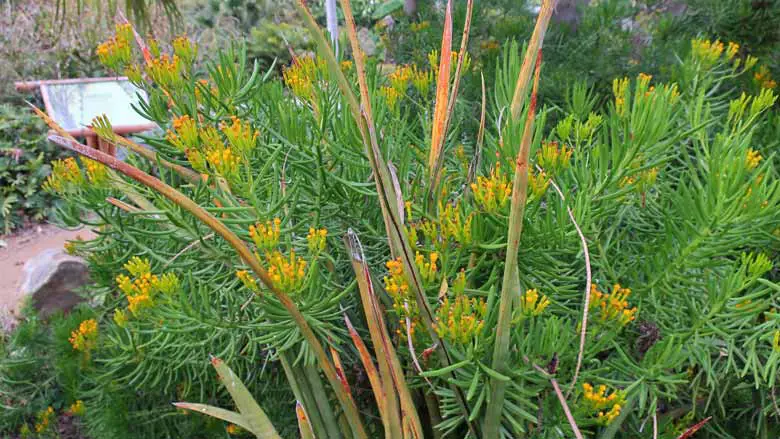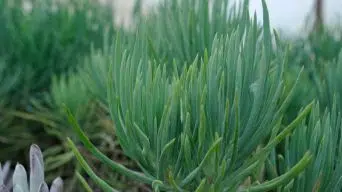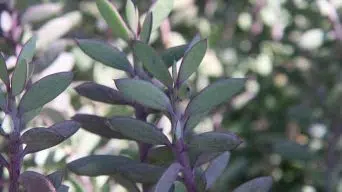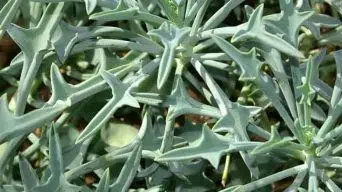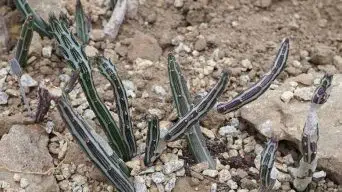Succulent plants have become very popular in recent years due to their low maintenance and drought-tolerant nature.
The Senecio barbertonicus is one of the many succulent plants to make its way into common households.
These plants are very easy to take care of and require very little attention, making them perfect for beginner gardeners.
This guide will teach you how to take care of and propagate the Senecio barbertonicus succulent.
Overview
Senecio barbertonicus, also known as the Succulent Bush Senecio, is an evergreen succulent shrub from the Asteraceae family that is native to Southern Africa.
The leaves of this Senecio plant are fleshy, cylindrical, and densely packed around the stems. They are light green and up to 4 inches (10 cm) long, with a diameter of 0.4 inches (1 cm).
The height and width of Senecio barbertonicus may reach 6 feet (1.8 m).
The flowers are yellow and up to 3 inches (7.5 cm) long, with a diameter of 0.4 inches (1 cm), which appear in late fall and winter.
Senecio barbertonicus is often known by the following names:
- Succulent Bush Senecio
- Barberton Senecio
- Barberton Groundsel
- Barberton Coltsfoot
- Lemon Bean Bush
How To Care for Senecio Barbertonicus (Succulent Bush Senecio)
Senecio Barbertonicus care is not difficult and quite straightforward.
Here you’ll find the essential information you need to know about caring for Succulent Bush Senecio.
Sun Exposure & Light Requirements
Senecio barbertonicus succulent plants do best in full sun to partial shade conditions.
They should be placed in an area that receives plenty of bright, indirect sunlight. They need at least six hours of direct sunlight a day.
If the succulent is being grown indoors, it should be placed near an east- or west-facing window, so it will receive plenty of indirect sunlight.
If grown outdoors, it should be in an area with full morning and afternoon sun but should be shaded from the hot midday sun.
Senecio barbertonicus succulents should not be placed in an area with full shade. They require at least six hours of direct sunlight a day to stay healthy.
Watering Requirements
Senecio barbertonicus succulents only require moderate watering, making them a perfect addition to any low-maintenance garden.
Watering should be done when the top inch of soil feels dry to the touch.
However, overwatering can quickly lead to root rot, so it is essential to avoid caution and water sparingly.
In general, they need to be watered every week or two in the summer and every month or two in the winter.
When watering, make sure the water runs through the soil and is thoroughly wet. Then, allow the soil to dry until just before it reaches the point of being considered dry.
Avoid getting water on the leaves of the plant, as this can cause them to rot. Only water the soil directly.
Soil Requirements
Senecio barbertonicus succulent plants prefer a soil mix that is light and well-draining.
A cactus mix or a succulent mix that is available at most garden stores will work well.
You can create your own mix by combining one part potting soil, one part coarse sand or gravel, and one part perlite.
Coarse sand or gravel help to keep the soil mix from becoming too dense and improve drainage.
Perlite helps to aerate the soil and keeps it from becoming too wet.
Ensure that the potting soil you use does not contain any added fertilizer, as this can be harmful to succulent plants.
Temperature and Humidity
Senecio barbertonicus needs an average temperature between 68° – 80° Fahrenheit (20 – 27°C) during the day and nights of 50° – 70° Fahrenheit (10 – 21°C).
Also, consider that Senecios are native to the arid areas in South Africa; therefore, they don’t like too much humidity.
For this reason, it’s best to keep the pot in a place where the humidity is below 40%.
Too much humidity can cause rot, so make sure that the pot drains appropriately and air circulation around it.
Fertilizing
Senecio barbertonicus does not need much fertilizing. In fact, over-fertilization can be harmful.
A balanced liquid fertilizer diluted to half-strength can be applied once a month during the growing season.
But be careful not to get the fertilizer on the plant’s leaves, as it can cause them to rot.
Since the Senecio barbertonicus is a succulent plant, it should not have fertilizer high in nitrogen because it does cause leaves to grow very quickly and become thin and limp.
Also, succulent plants should not be fertilized during winter, making them more susceptible to rot and diseases.
Potting and Repotting
When planting or repotting a Senecio barbertonicus, be sure to use a pot with a drainage hole so that the plant can drain properly.
If you are planting the individual in a container that does not have a drainage hole, create one by breaking or cutting out an area of the pot.
Use terracotta or clay pots because they allow the soil to dry faster than plastic pots.
The pot size depends on how large the plan is and how many plants you intend to plant in a shared container.
When planting multiple Senecio barbertonicus succulents in one container, it is best to group them by similarity in height and arrange them so they do not tower over each other.
You want to ensure that the Senecio barbertonicus doesn’t tower over its neighboring plants since they can grow quite tall and take up a lot of room.
If planting multiple Senecio succulents close together, it is best to give them enough space not to touch one another, as this may cause leaves to turn yellow, brown, or black.
To properly plant Senecio barbertonicus, fill the bottom third of the pot with a fast-draining soil mix.
Place the succulent in the pot and fill in around it with more soil mix. Tamp down gently to ensure good contact with the soil.
Don’t water the succulent for a few weeks after repotting to allow the roots to become established. After that, water when the top inch of soil feels dry to the touch.
Pruning
Senecio barbertonicus are typically easy plants to care for, but they do have one requirement that is unique from other succulents: they need to be pruned.
Pruning helps keep the plant compact and prevents it from growing too tall and spindly.
Prune the plant by cutting off the stem just above a leaf node.
This node will likely have a tiny new offshoot sprouting, so snap the stem above that node.
Pruning also stimulates new growth to replace the pruned stems, so do not be concerned if your plant appears to be dwindling after you cut off some of its branches.
Also, removing damaged and dead branches can help keep your Senecio barbertonicus healthy.
It’s best to prune your plant during the spring before new growth begins.
Pests and Diseases
Senecio barbertonicus succulent plants are generally quite hardy and don’t suffer from many pests or diseases. However, mealybugs, scale, and root rot can sometimes be a problem.
Mealybugs
Mealybugs are small, soft-bodied insects that can infest a wide variety of plants.
They secrete a sticky substance that can cover the leaves and stems of the plant, making it difficult for the plant to photosynthesize.
Mealybugs can be treated with insecticidal soap or horticultural oil.
Scale
Scale is a hard-shell insect that sucks the sap from a plant, which can damage or even kill it.
These insects are most common along the stem and leaf joints of the plant.
They can be treated by dabbing with isopropyl alcohol on a cotton swab.
Be aware that this method will also kill any healthy insects still present on the plant.
Root Rot
Root rot is caused by fungi or bacteria that can infect the roots of a succulent.
The plant will begin to wilt and may even fall over and won’t grow new leaves.
Root rot is most common during wet weather, especially if the soil isn’t well-draining.
Fungus gnats are also attracted to these conditions, so you can help prevent root rot by keeping the soil dry and getting rid of any fungus gnats you may have.
You can also treat an infected plant with a fungicide.
How to Care for Senecio Barbertonicus (Succulent Bush Senecio) in Winter
Senecio barbertonicus care during the winter season is minimal.
The Succulent Bush Senecio can be left outside in a cold climate if the temperature does not drop below freezing.
It is best to move the succulent indoors in colder climates and place it in a bright and sunny window.
Ensure the succulent is not in direct contact with any cold drafts, which can cause damage to the leaves.
Watering should be reduced during the winter, allowing the soil to dry out between waterings.
This will help to prevent rot. If the plant is grown in a container, be sure not to overwater.
Senecio barbertonicus can handle a small amount of water, but for the most part, it should be left to dry out between watering.
Also, the succulent should not be fertilized during the winter, so be sure to hold off on fertilizing until the growing season.
How To Propagate Senecio Barbertonicus (Succulent Bush Senecio)
Senecio barbertonicus can be propagated from cuttings or seeds.
Cuttings
Senecio barbertonicus can be propagated from cuttings.
- Cut a healthy stem from the succulent and allow the cut end to dry for a day or two.
- Fill a pot with succulent or cactus potting mix.
- Dip the cut end of the stem in rooting hormone powder.
- Insert the stem into the potting mix and firm it in place.
- Water the pot well and keep it in a sunny location.
Roots should begin to form in a few weeks, and the succulent can be transplanted into a larger pot when it is established.
Seeds
Senecio barbertonicus can also be propagated from seeds.
- Collect seeds from the succulent plant when it begins to produce them.
- Sow the seeds in a pot filled with succulent or cactus potting mix.
- Water the potting mix until it is thoroughly moist.
- Place the pot in a warm location and keep it out of direct sun.
The seeds will sprout in one to three weeks.
Once the seedlings have sprouted, transplant them into small pots filled with cactus potting mix.
When they are established, they can be planted in the garden.
Final Thoughts
Succulents are a great addition to any house, office, or outdoor space. They provide a beautiful and practical look with a fantastic texture.
Furthermore, succulents are very easy to care for and propagate in general!
Senecio barbertonicus is a perfect succulent to add to your collection, as it is low-maintenance, drought-tolerant, and relatively hardy.
With a little bit of care and some basic knowledge about propagation, you can have this beautiful succulent thriving in no time!

